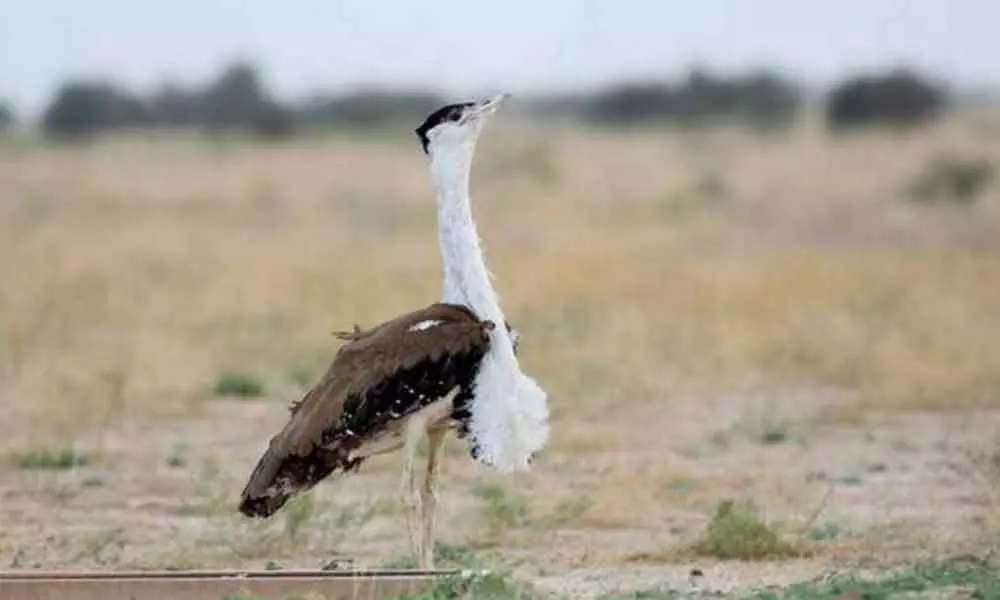Live
- Boxing Day Test Weather Forecast: Rain Delays Expected on Day 3 and Day 4 in Melbourne
- Baby John Twitter Reviews: Varun Dhawan Impresses, But Fans Feel the Remake Lacks Theri's Charm
- Pakistan Air Strikes Kill 46 in Afghanistan, Taliban Confirms Amid Rising Tensions
- ACB Launches Investigation into Formula E Races Held in Hyderabad Last Year
- Mega Job Mela in Madhapur on December 28: Explore Employment Opportunities in Hyderabad
- New Mizoram Guv likely to take charge next week
- Barroz 3D Movie Review: A Visual Treat for Mohanlal Fans, Mixed for Others
- Donate Blood, Save Lives: BJP Hosts Mega Blood Donation Camp in Aiza
- Azerbaijani Airliner Crashes Near Aktau, Kazakhstan: 32 Survive, Over 30 Feared Dead
- Union Minister Bandi Sanjay Kumar to Visit Jogulamba Gadwal District on December 27, 2024
Just In
New Delhi: Move afoot to protect Great Indian Bustard


Seeking to protect the critically endangered Great Indian Bustard, the Union Environment Ministry has decided to declare their habitats as conservation reserves and asked power companies to consider placing high voltage lines under the ground as the birds have died after coming in contact with them.
New Delhi (PTI): Seeking to protect the critically endangered Great Indian Bustard, the Union Environment Ministry has decided to declare their habitats as conservation reserves and asked power companies to consider placing high voltage lines under the ground as the birds have died after coming in contact with them. During a meeting held by a committee under the ministry, constituted in pursuance to the directions of the National Green Tribunal, it was also decided to have time bound action plan for the implementation of mitigation measures such as installation of bird diverters and their regular maintenance and monitoring by power agencies.
"All the powerline development agencies already working in GIB habitat or intend to work should be invited especially to discuss and consider the technological and economic feasibility of under-grounding different capacity of power lines," Siddhanta Das, DG Forests and Special Secretary, who chaired the committee meeting, said. As per a report by the Wildlife Institute of India (WII), a statutory body under the ministry of environment, only 150 GIBs are left in India, out of which around 90 per cent are found in Rajasthan and Gujarat. The committee, after its meeting held recently, also directed the WII to furnish the details about power lines identified for mitigation in the GIB habitat area along with details of power line owners to the ministries of power and non renewable energy so that necessary action may be initiated.
The GIBs are dying at the rate of 15 per cent annually due to collision with high voltage power lines, the WII report had said, adding that their population has been reduced by 75 per cent in the last 30 years. The report had compiled various studies conducted by researchers across the country on GIBs. "Mortality of adult GIBs is high due to collision with power lines that criss-cross their flying path. All bustards are prone to collision due to their poor frontal vision and inability to see the power lines from a distance," it had said.
The issue came to light after a petition was filed in the NGT seeking conservation of GIB to save them from extinction. The NGT directed constitution of a committee to look into it on plea of Bhanu Bansal, secretary of NGO Centre for Wildlife and Environmental Litigation (CWEL). Some of the demands the NGO has been making include declaring critical GIB habitat as inviolate area, disallowing new wind turbines at GIB areas, undergrounding power lines from 33 kilo volt to 440 kv and imposition of exemplary cost on power line companies which fail to oblige. WII's research has shown that power lines, particularly high voltage (33-440 KV) transmission lines with vertical alignment are the biggest threat to GIB as of now and their habitats have a high density of transmission lines because of the impetus on renewable energy production in GIB habitats of Rajasthan and Gujarat.
"The study recorded 5 GIB deaths in 2017-18 in Jaisalmer alone and calculated that 15 per cent of the GIB population may be dying because of this threat. Since the natural death rate of large bustards is 4-8 per cent, the current additive mortality rate due to transmission lines is significantly higher and if not controlled, can result in the species extinction," the WII said. It said that maximum number of GIBs were found in Jaisalmer and the Indian Army controlled field firing range near Pokhran, Rajasthan.
Other areas where they are found in less than 10 in number are Kutch district in Gujarat, Nagpur, Amravati and Solapur districts in Maharashtra, Bellary and Koppal districts in Karnataka and Kurnool district in Andhra Pradesh. The GIB is one of the heaviest flying birds endemic to the Indian subcontinent. They are primarily terrestrial birds with adult males as tall as 122 cm and weigh 11-15 kg and adult females reach up to 92 cm and weigh 4-7 kg, the WII said. According to the report, the GIB lays one egg every 1-2 years and the success rate of these eggs is 60-70 per cent.
However, this rate has been reduced to 40-50 per cent due to predators like fox and dogs. As per researchers, apart from the GIB, many other birds also die because of collision or electrocution with these transmission lines at the rate of 10 birds per km per month totalling nearly one lakh bird deaths annually in 4200 sq km. The government has already released Rs 33 crore for the conservation of the GIB through a project, titled 'Habitat Improvement and Conservation Breeding of Great Indian Bustard-An Integrated Approach', for five years from the Compensatory Afforestation Fund Management and Planning Authority (CAMPA) for conservation, breeding of the GIB with technical support from the WII.

© 2024 Hyderabad Media House Limited/The Hans India. All rights reserved. Powered by hocalwire.com






